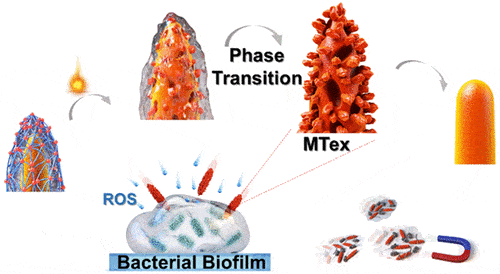A team of researchers managed to control the surface texture of nanostructures that will help in the fight against antibiotic-resistant bacteria

[Translation by Dr. Moshe Nachmani]
The corona epidemic raises fears of new disease-causing agents such as new viruses or drug-resistant bacteria. To address this concern, a team of Korean researchers recently focused their attention on developing a technology that enables the elimination of drug-resistant bacteria while controlling the surface texture of nanomaterials. The researchers developed surface-textured nanostructures based on a mixture of iron oxide/cobalt that functions as a highly efficient magneto-catalytic substrate. Their findings have long been published in the scientific journal Nano Letters.
In the first step, the researchers synthesized nanocrystals with a smooth surface in which a variety of metal ions were wrapped in an organic polymer shell while heating them to extremely high temperatures. During the heating of the polymer shell, a chemical reaction occurs in a solid state and at a high temperature that causes the mixing of the various metal ions on the surface of the nanocrystal while creating nanometer-sized holes and branches on the surface.
This unique surface texture has been found to catalyze a chemical reaction that creates reactive oxygen species (ROS), species that enable the destruction of bacteria. The surface was also found to be highly magnetic and easily attracted to an external magnetic field. In other words, the researchers found a synthetic method to convert ordinary nanocrystals into highly functional mixed metal-oxide nanocrystals. The research team called this surface topography - which appears as branches and nozzles and resembles a plowed field - MTex.
Increasing the speed of the nanoparticles
The researchers verified that this unique surface texture increases the movement of nanoparticles and thus allows them to penetrate effectively into a biofilm substrate while demonstrating a high activity of creating active oxygen species, the same species known to be lethal to bacteria. This system produces the compounds in a wide range of acidity values (pH) and these are able to effectively flutter into the biofilm and eliminate the drug-resistant bacteria embedded there. In light of the fact that these nanostructures are magnetic, it will be possible to collect out the biofilm residues even from microstructures with accessibility challenges.
"These innovative structures demonstrate high catalytic activity," explains one of the co-authors of the scientific article. "This characteristic is particularly useful in penetrating into biofilm that is even in tiny spaces and is effective in eliminating bacteria and removing biofilm." "In addition, the researcher explains, this research enables control over the surface texture of nanostructures, a feature that opens a window to many opportunities in terms of the level of exposure and the development of active sites." And the main researcher of the study adds and says: "We anticipate that our innovative nanoscale structures will contribute significantly to the development of an extensive collection of enzyme-like systems at the interface between the nanoscale and the biological."
More of the topic in Hayadan:
- Break down walls - and heal
- Our strength is in our unity
- A state-of-the-art microfluidic device helps to understand biological processes
- Researchers from the Hebrew University have developed semiconductor nanocrystals with improved electrical function
- Researchers at Tel Aviv University have developed antibacterial nanostructures that can be incorporated into dental restoration materials (fillings)
